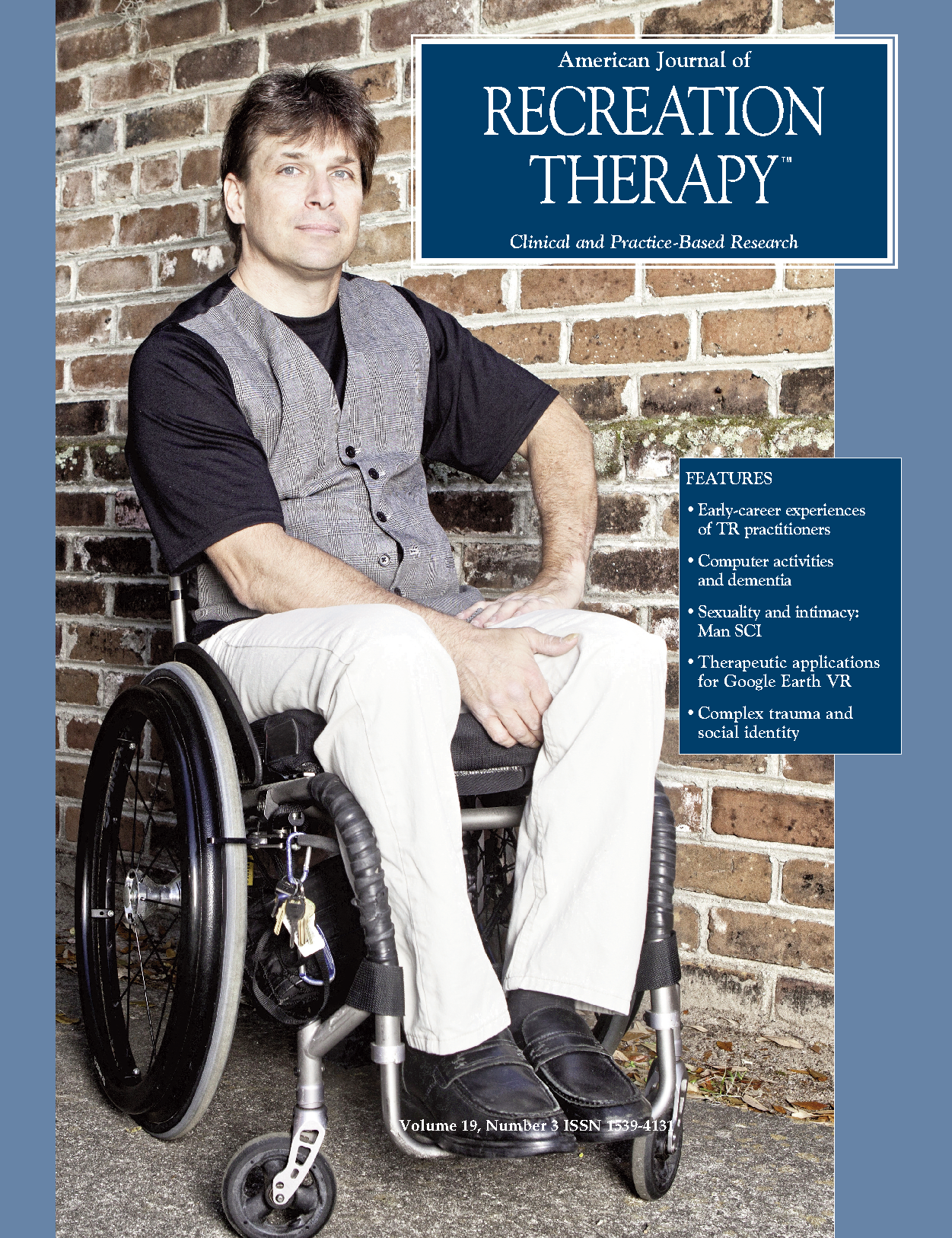Exploring therapeutic applications for Google Earth VR
DOI:
https://doi.org/10.5055/ajrt.2020.0218Keywords:
Google Earth VR, recreational therapy, therapy, travel, virtual realityAbstract
Virtual reality (VR) is a technology frequently used for both recreation and healthcare service delivery. Yet, little is known about the applicability and use of specific VR applications in recreational therapy (RT) practice. Google Earth VR is a popular application that allows users to virtually travel to different locations around the world. It could have relevance in patient-centered treatment that addresses a variety of RT treatment goals. Using a focus group of RTs (N = 8), this study examined possible uses of Google Earth VR in RT treatment. Following an education and training session providing an overview of VR equipment and the Google Earth VR application, participants engaged in clinical role play from both a therapist and client perspective. This was followed by a focus group discussion where therapists were asked to identify possible treatment uses for Google Earth VR with the clients they serve. Four main themes emerged, including reminiscing, community integration/leisure education, social skills development, and distraction/pain management. Findings indicate RTs view Google Earth VR as a resource with potential therapeutic applications for new and innovative treatment. The identified treatment focus areas also provide guidance for professional resource development and future research studies.
References
Triberti S, Liberati EG: Patient centered virtual reality: An opportunity to improve the quality of patient’s experience. In Cipresso P, Serino S (eds.): Virtual Reality: Technologies, Medical Applications and Challenges. Hauppauge, New York: Nova Science, 2015.
Mosadeghi S, Reid MW, Martinez B, et al.: Feasibility of an immersive virtual reality intervention for hospitalized patients: An observational cohort study. JMIR Ment Heal. 2016; 3(2): e28. DOI: 10.2196/mental.5801.
Malloy KM, Milling LS: The effectiveness of virtual reality distraction for pain reduction: A systematic review. Clin Psychol Rev. 2010; 30: 1011-1018. DOI: 10.1016/j.cpr.2010.07.001.
Aukstakalnis S, Blatner D: Silicon Mirage: The Art and Science of Virtual Reality. Berkeley: Peachpit Press, 1992. 5. Virtual Reality. Oxford English Dictionary. 2013. Available at https://www.oed.com/view/Entry/328583?redirectedFrom=virtual+reality#eid. Accessed December 10, 2019.
Slater M, Sanchez-Vives MV: Enhancing our lives with immersive virtual reality. Front Robot AI. 2016; 3(74): 1-47.
Cummings JJ, Bailenson JN: How immersive is enough? A meta-analysis of the effect of immersive technology on user presence. Media Psychol. 2016; 19(2): 272-309. DOI: 10.1080/15213269.2015.1015740.
Rose T, Nam CS, Chen KB: Immersion of virtual reality for rehabilitation—review. Appl Ergon. 2018; 69: 153-161.
Rizzo A, Shilling R: Clinical virtual reality tools to advance the prevention, assessment, and treatment of PTSD. Eur J Psychotraumatol. 2017; 8(5): 1-20. DOI: 10.1080/20008198.2017.1414560.
Tsyktor V: What is semi-immersive virtual reality?—The technology simplified. CyberPulse. 2019. Available at https://cyberpulse.info/what-is-semi-immersive-virtual-reality/. Accessed February 12, 2020.
Yeo E, Chau B, Chi B, et al.: Virtual reality neurorehabilitation for mobility in spinal cord injury: A structured review. Innov Clin Neurosci. 2019; 16(1-2): 13-20.
Lee SH, Jung H-Y, Yun SJ, et al.: Upper extremity rehabilitation using fully immersive virtual reality games with a head mount display: A feasibility study. PM R. 2019; 12(3): 257-262. DOI: 10.1002/pmrj.12206.
Freina L, Ott M: A literature review on immersive virtual reality in education: State of the art and perspectives. In Proc eLearning Softw Educ (eLSE), Bucharest, Rom April 23-24, 2015. 2015: 8. DOI: 10.12753/2066-026X-15-020.
Paynter B: A virtual global travel pass. Fast Company. 2018. Available at https://
www.fastcompany.com/90227520/a-virtual-global-travel-pass. Accessed February 12, 2020.
Käser DP, Parker E, Glazier A, et al.: The making of Google Earth VR. ACM SIGGRAPH Talks. 2017; 63. DOI: 10.1145/3084363.3085094.
Niki K, Okamoto Y, Maeda I, et al.: A novel palliative care approach using virtual reality for improving various symptoms of terminal cancer patients: A preliminary prospective, multicenter study. J Palliat Med. 2019; 22(6): 702-707. DOI: 10.1089/jpm.2018.0527.
Carlsen B, Glenton C: What about N? A methodological study of sample-size reporting in focus group studies. BMC Med Res Methodol. 2011; 11(26): 1-10. DOI: 10.1186/1471-2288-11-26.
Published
How to Cite
Issue
Section
License
Copyright 2000-2025, Weston Medical Publishing, LLC and American Journal of Recreation Therapy. All Rights Reserved.


